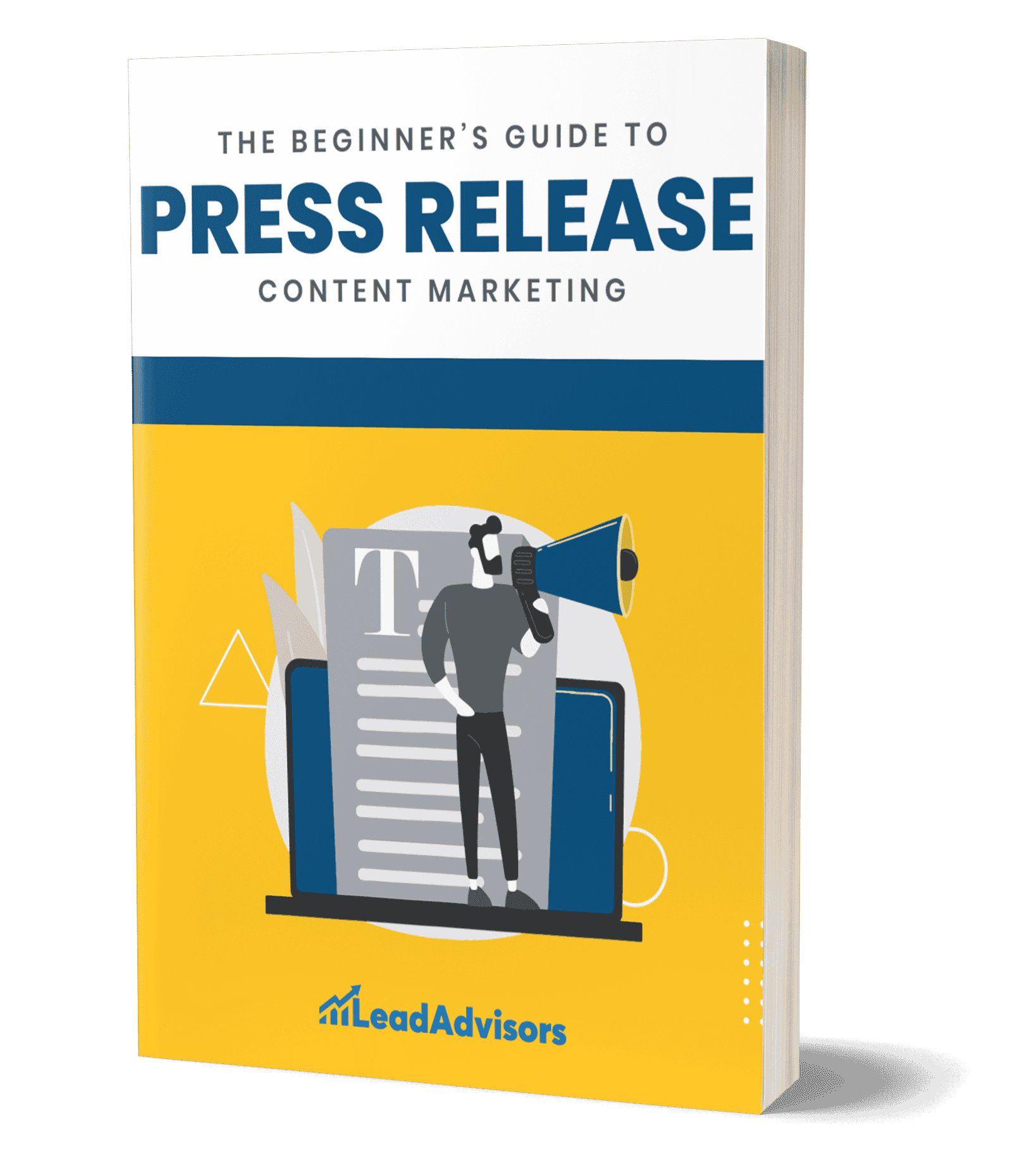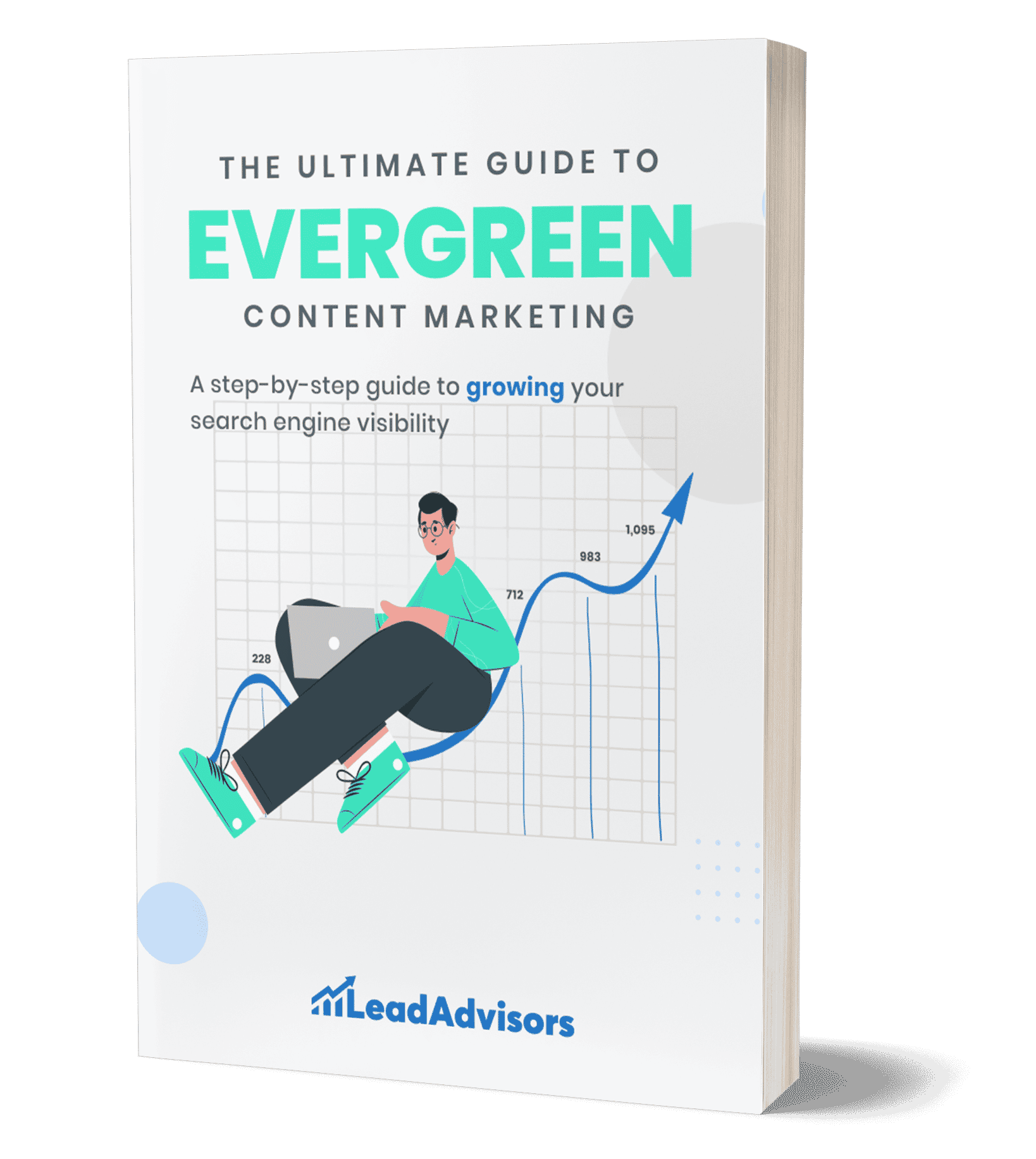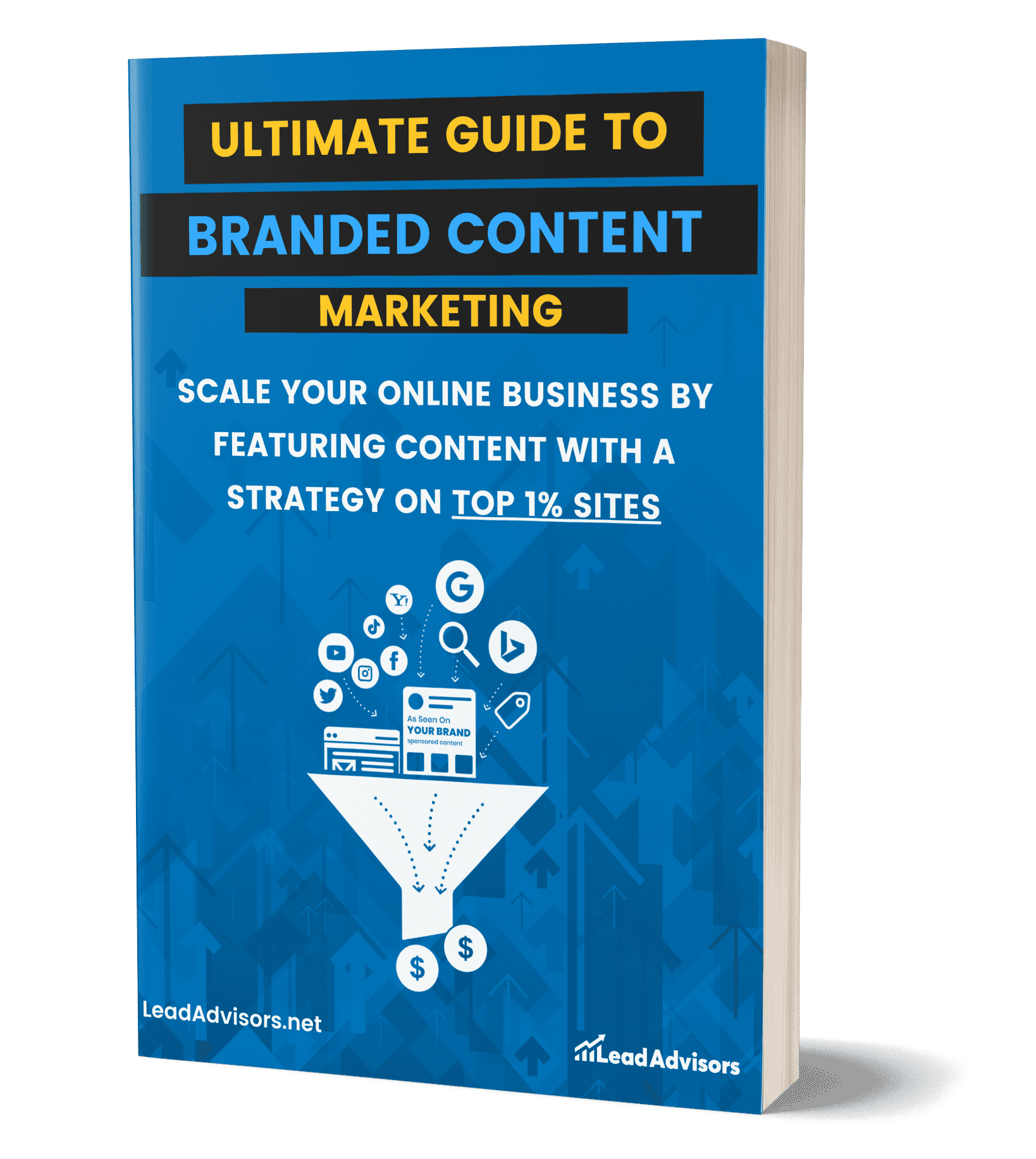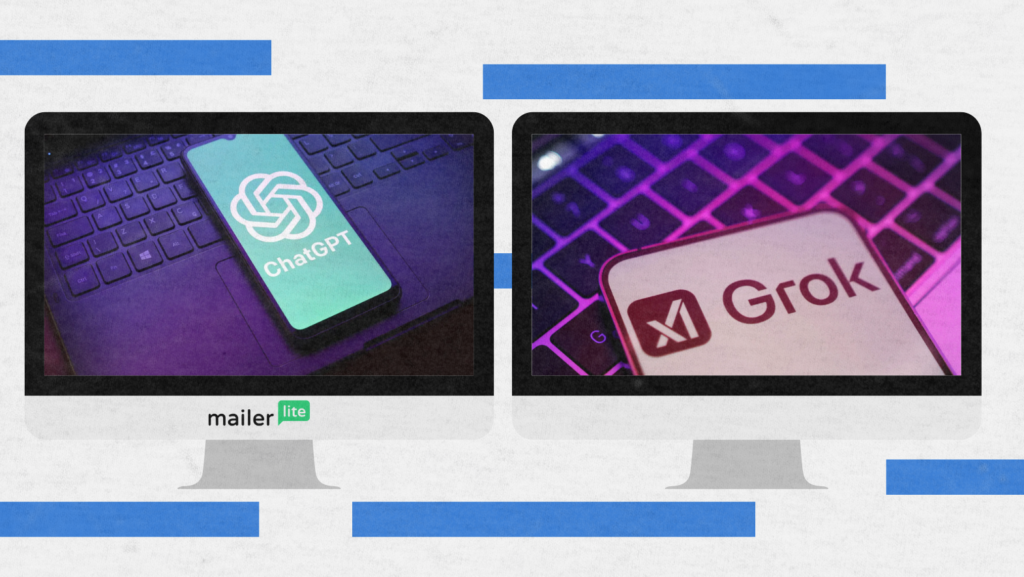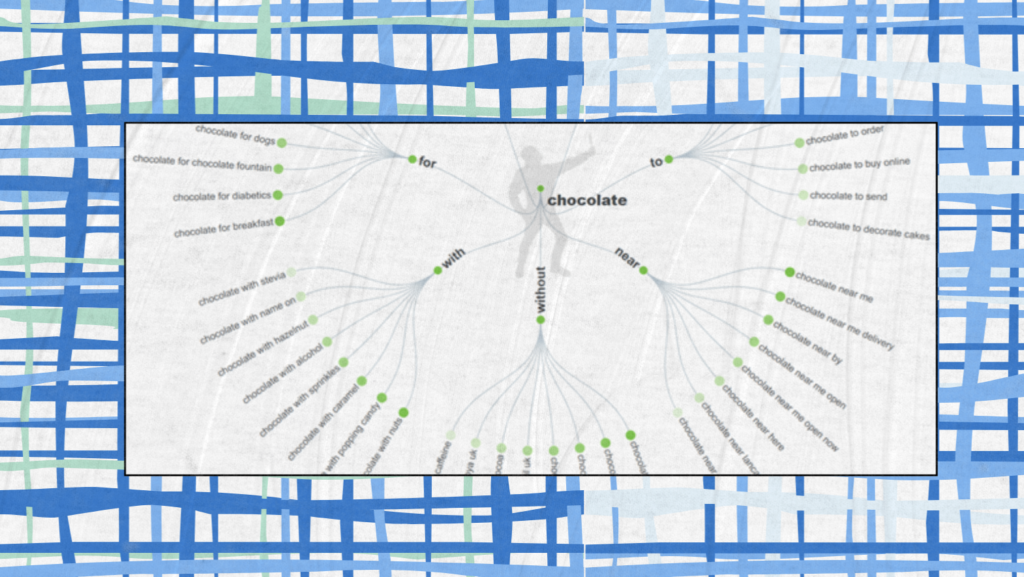Creating a website is only half the work. The question of the hour is how to get people to visit it. If you are running an online business or a traditional store that also has a digital presence, the ability to promote your website effectively is what separates the silent mode from the conversion mode.
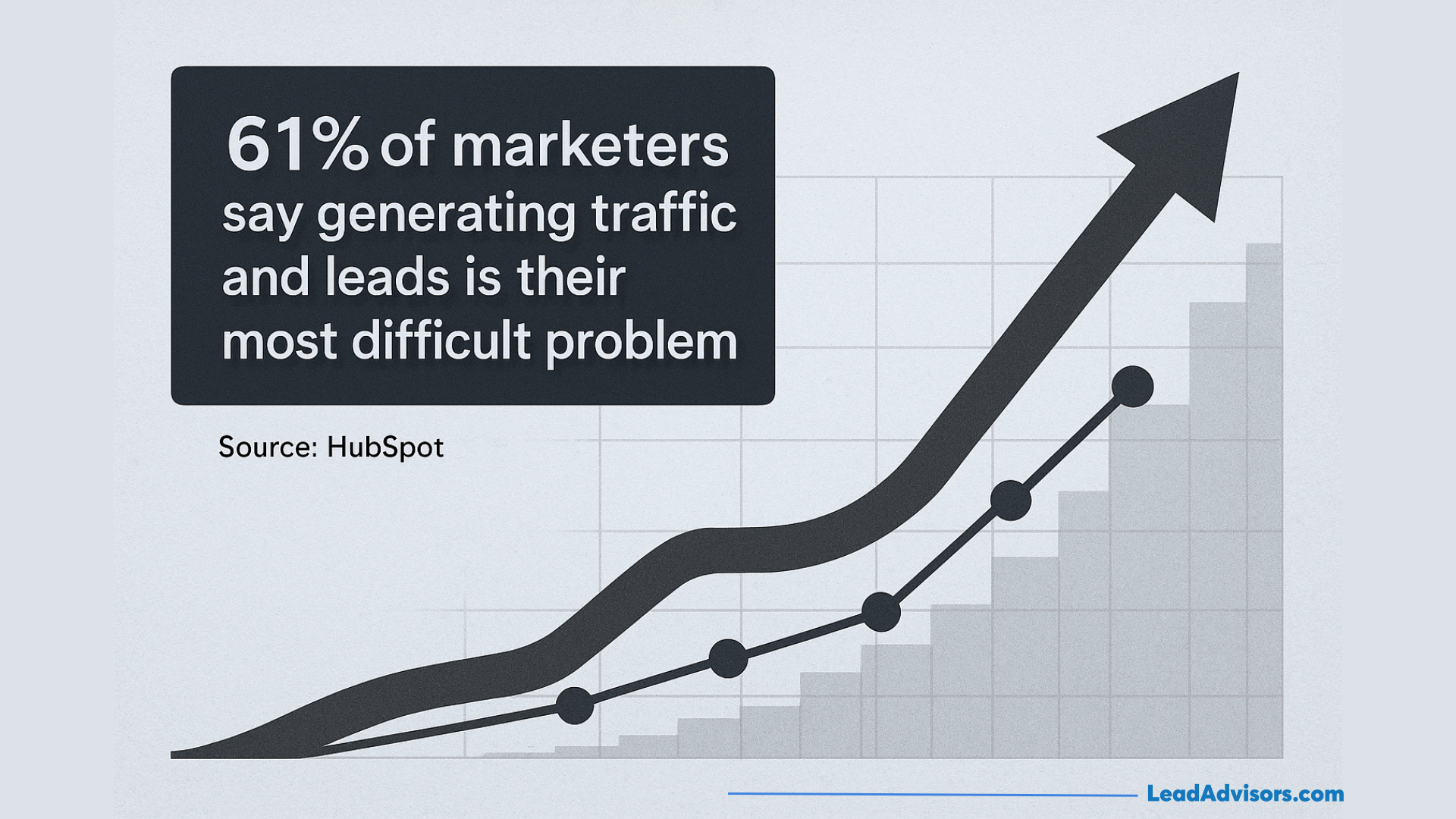
According to a report by HubSpot, 61% of marketers consider the generation of traffic and leads as their most difficult problem. This detailed guide delves into the effectiveness and popularity of the different promotional strategies through their endorsement by experts and confirmation by data.
TL;DR
Promoting a website in 2025 comes down to building a strong technical foundation, optimizing for search, and consistently creating content that answers real user needs. High-quality SEO drives most long-term traffic, while content marketing, social platforms, editorial features, email campaigns, and community engagement amplify reach. The strongest results come from combining multiple channels, tracking performance, and improving based on data rather than guessing.
Ensure Your Website Is Promotion-Ready
Firstly, your site should be a true reflection of User-Centered Design/UX, Expertise, Authoritativeness, and Trustworthiness, which are the main factors Google employs to assess the quality of content, before you can think of executing any promotion plans. The 2024 study of Stanford Web Credibility Research reported that as many as three-quarters of the users put the credibility of a company solely on the design of the website.
Technical Essentials
Website performance directly influences both search engine rankings and visitor retention. According to Google’s own research, 53% of mobile users abandon sites that take longer than three seconds to load. Here’s what matters most:
| Technical Element | Why It Matters | Performance Target |
| Fast loading speed | Users expect instant results; slow sites lose 53% of mobile visitors | Under 3 seconds |
| Mobile responsiveness | 58.67% of global website traffic comes from mobile (Statista, 2024) | Perfect on all devices |
| HTTPS security | 17% abandon carts due to security concerns (Baymard Institute) | SSL certificate required |
| Clean navigation | 46% cite navigation as top credibility factor (Stanford) | 3-click rule maximum |
According to research by Portent, a website that loads in 1 second has a conversion rate that is 3 times higher than that of a website that loads in 5 seconds.
Implementing schema markup helps the search engines to grasp the content context of your website – as per the data from Search Engine Land, pages with schema markup on average move up 4 positions in the search results.
Analytics Setup
Put in monitoring and measuring systems such as Google Analytics in order to know the behavior of the visitors, from where the traffic is coming, and what the conversion paths of the conversions are.
According to the Digital Analytics Association, companies that implement sophisticated analytics report returns that are 93% higher than those of their competitors. Use Google Search Console to keep track of the way search engines are crawling and indexing your site – Moz research suggests that this is a source of ranking opportunities, with 54% more success than just using keyword research tools.
Master Website SEO (Your #1 Free Traffic Source)
Search engine optimization represents the most cost-effective long-term strategy for sustainable website traffic. BrightEdge research indicates that organic search drives 53.3% of all website traffic, compared to just 15% from paid search. If you want to know how to promote your website without constantly spending money, SEO is your answer.
Keyword Strategy
Keyword research forms the fundamental foundation of any effective SEO strategy. According to Ahrefs’ analysis of 1.4 billion keywords, long-tail keywords (3+ words) account for 92.42% of all search queries yet face significantly less competition.
Short-tail vs. long-tail keywords
Short-tail terms like “shoes” have high search volume but intense competition. Long-tail phrases like “comfortable running shoes for flat feet” face less competition and indicate higher search intent. WordStream research shows long-tail keywords convert 2.5x better than generic terms. This principle applies whether you’re learning how to build a website or figuring out how to promote your website.
Mapping keywords to intent
MIT research on search behavior reveals that understanding why users search Google or type a URL matters more than volume alone. Classify keywords by intent:
- Informational: Learning (“what is SEO,” “SEO meaning,” “what does meta mean”)
- Navigational: Finding specific sites (“Google Business Profile,” “Google support”)
- Commercial investigation: Comparing options (“best SEO tools,” “SEO services vs DIY”)
- Transactional: Ready to act (“hire SEO company,” “SEO services near me”)
Creating Keyword Clusters
Group related keywords around core topics to build topical authority. SEMrush analysis of 600,000 articles found that content targeting keyword clusters ranks for 45% more relevant keywords than single-focus content. For example, cluster “how to build a website,” “create a website,” “make a website,” and “create website” into one comprehensive guide.
Competitor Keyword Analysis
Use keyword research tools like Ahrefs, SEMrush, or Moz to identify what keywords competitors rank for. According to Search Engine Journal, this competitive intelligence reveals opportunities 47% faster than manual research. Look for gaps where competitors rank but you don’t—these represent quick wins to capture traffic they’re already getting.
Read more about: Keyword Research 101: How to Find the Best Keywords
On-Page SEO
On-page SEO involves optimizing individual pages to rank higher in search engine results. According to Backlinko’s analysis of 11.8 million Google search results, several factors consistently correlate with higher rankings.
Meta Titles & Descriptions
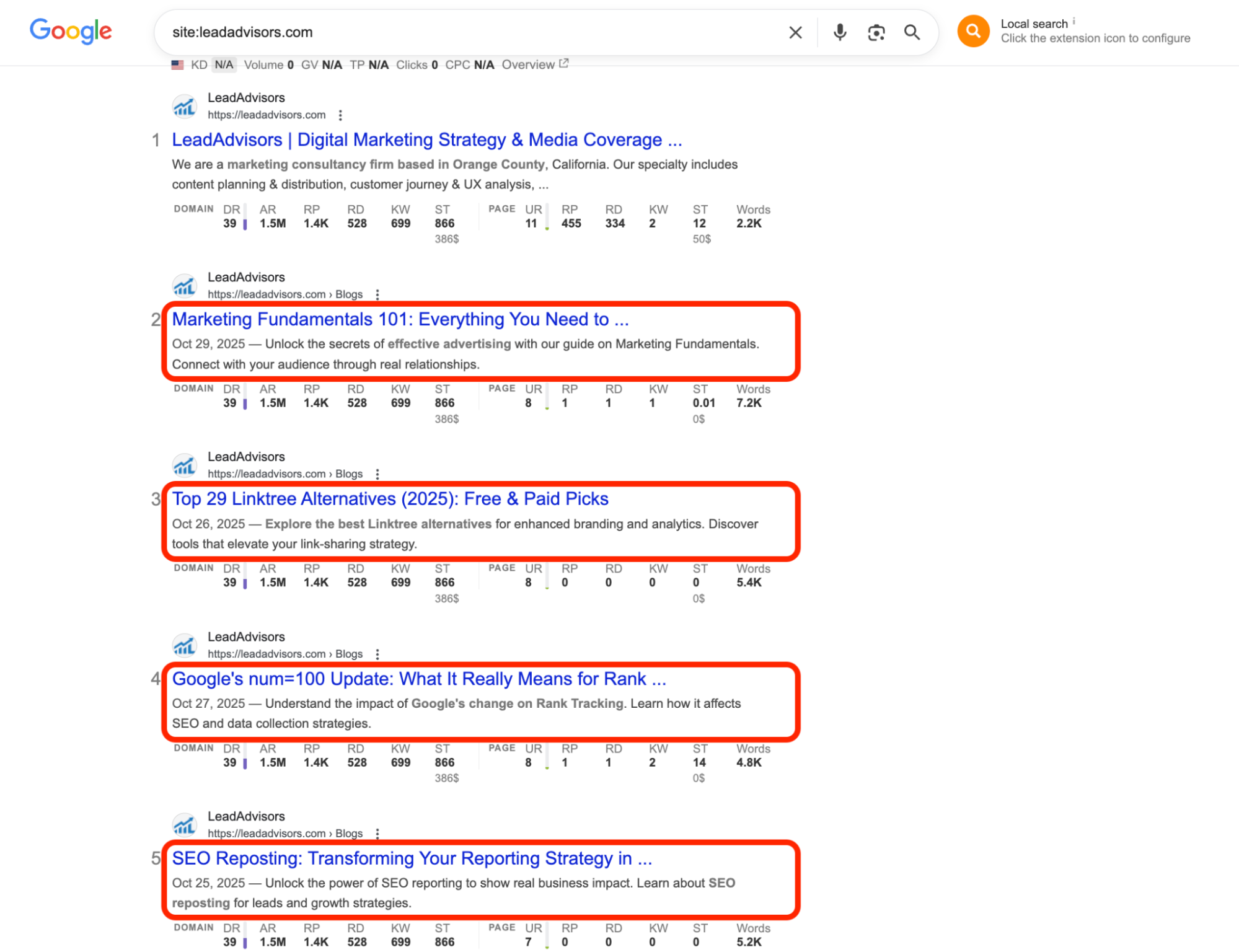
Keep titles under 60 characters to prevent truncation in search results. Carnegie Mellon University research shows compelling titles can increase click-through rates by up to 20%. While meta descriptions aren’t a direct ranking factor (understanding what meta means in this context is important), Moz’s research indicates well-crafted descriptions improve CTR by 5-10%.
Header Hierarchy
Proper H2, H3, H4, and H5 structure helps search engines understand content organization. SEMrush found that content using proper header tags receives 36% more engagement. These are SEO best practices that make your content scannable for both humans and bots.
First 100 Words Optimization
Front-load primary keywords naturally in opening paragraphs. Research from Yoast shows that keyword placement in the first 100 words correlates with 15% better rankings. Do it naturally—keyword stuffing will hurt more than help.
Image Alt Text + File Naming
Descriptive alt text improves accessibility and SEO. A study by John Mueller from Google confirmed that image alt attributes help pages rank in both web and image search. Instead of “image123.jpg,” use “comfortable-running-shoes-flat-feet.jpg” with alt text describing what’s shown.
Internal Linking Structure
Internal links distribute page authority and improve crawlability. Princeton research found that strategic internal linking increases indexed pages by 40% and improves user experience by reducing clicks to desired content. Link relevant pages together to show search engines the relationships between your content.
Read more about: How to Improve On-Page SEO for Your Business Website
Technical SEO
Technical SEO ensures search engines can effectively crawl, index, and rank your site. Sistrix found that technical issues cause 35% of all indexation problems.
Crawlability & Indexation
Use Search Console to identify and fix crawl errors. Ensure your robots.txt file doesn’t accidentally block important pages. DeepCrawl found that the average website has 35% of its pages blocked from indexing unintentionally. Your robots.txt tells search engines which pages to crawl and which to skip—misconfiguration can make your website invisible.
Fixing Broken Links
Broken links damage user experience and waste crawl budget. Ahrefs shows that the average site has broken links on 35% of its pages, directly impacting search rankings. Every 404 error is a missed opportunity where visitors hit dead ends and search engines can’t follow your site structure.
Sitemaps
XML sitemaps help search engines discover all your pages efficiently. Research from Google Webmaster Central confirms proper sitemap implementation can increase indexation rates by 40-60%. Submit your sitemap through Google Search Console and update it automatically whenever you publish new content.
Core Web Vitals
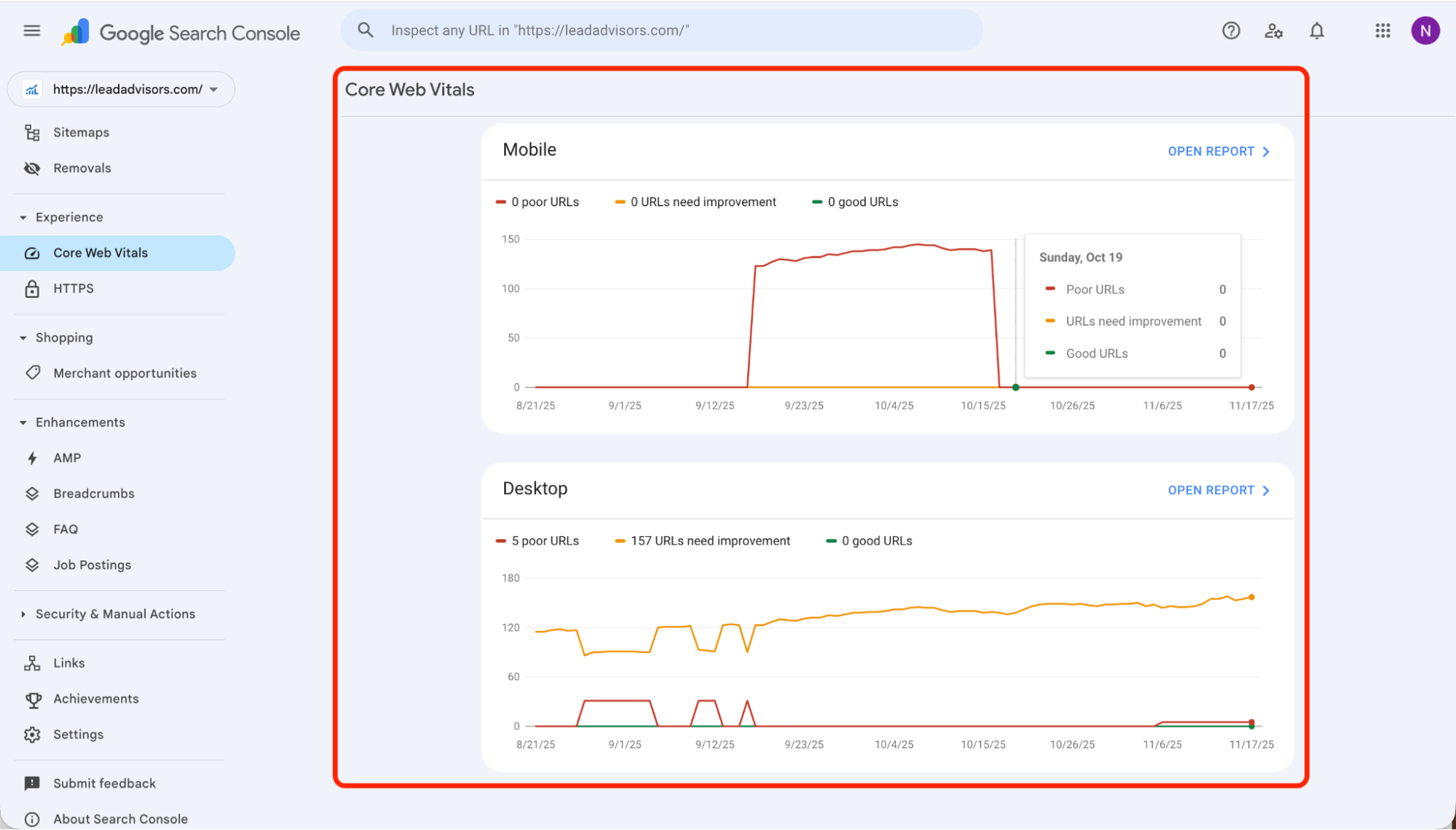
Google’s 2024 page experience update made Core Web Vitals official ranking factors. Web.dev research shows sites meeting all thresholds have 24% lower abandonment rates. These metrics measure real user experience—Largest Contentful Paint (under 2.5 seconds), First Input Delay (under 100 milliseconds), and Cumulative Layout Shift (under 0.1).
Read more about: Mastering Technical SEO: Boost Your Website’s Performance
Off-Page SEO
Off-page SEO encompasses activities outside your website that impact search rankings. According to Moz’s 2024 Search Ranking Factors study, backlinks remain among the top three ranking factors.
Earning Backlinks
High-quality backlinks act as votes of confidence from other websites. Ahrefs’ analysis of 111 million domains found sites with backlinks from 200+ referring domains receive 4.4x more traffic than those with fewer than 50. Focus on earning links from industry publications, educational institutions (.edu), government resources (.gov), and established news outlets.
Strategic Partnerships
Collaborate with complementary businesses serving the same target audience but offering different products. Wharton School research shows partnerships generate 67% more reach than solo efforts while building valuable backlinks. This collaborative approach to link building delivers compounding returns.
Brand Mentions
Even unlinked brand mentions contribute to authority. Moz found correlations between unlinked mentions and rankings, suggesting Google uses brand signals beyond traditional backlinks. When reputable sites mention your brand name, it signals authority even without direct links.
High-Authority Editorial Reviews
Third-party editorial features on established platforms drive traffic and SEO benefits. Nielsen’s Global Trust in Advertising study shows 88% of consumers trust editorial content over advertising. BrightLocal’s 2024 research found businesses featured in editorial reviews see a 43% increase in branded search volume within 30 days, with referral traffic showing 2.7x higher engagement rates than social media traffic.
Read more about: Best Techniques to Execute a Strong Off-page SEO Strategy
Refresh Existing Content
Updating existing content yields better ROI than creating new pieces. HubSpot shows that updating and republishing old blog posts can increase organic search traffic by 106%.
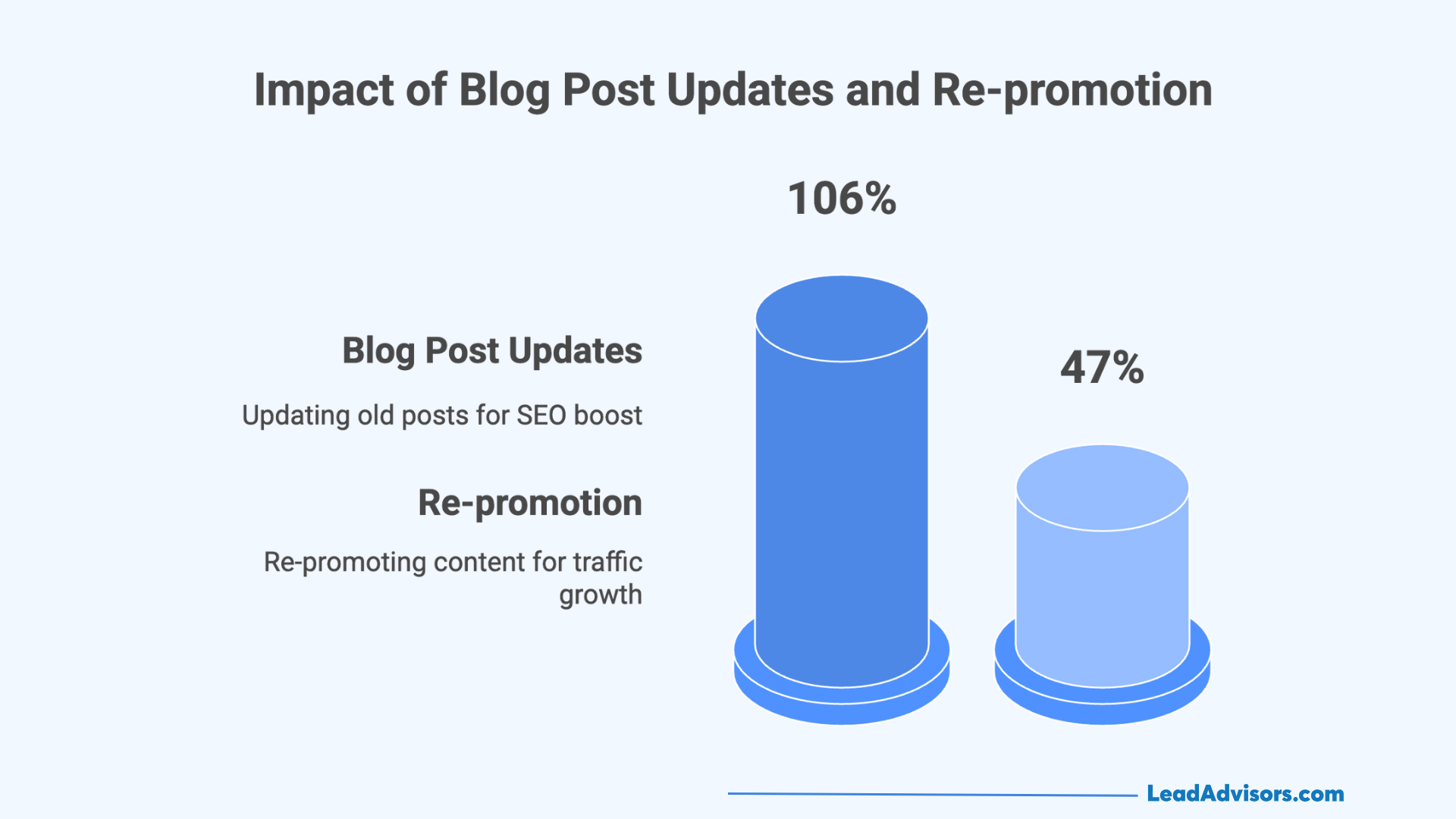
Update facts, keywords, visuals: Refresh statistics with current research, add new relevant keywords discovered through keyword research, and replace outdated images. Ahrefs research shows content updated within the last year ranks higher than older, stale content.
- Improve readability: Break up long paragraphs, add subheadings, and use shorter sentences. The Nielsen Norman Group found that web users scan rather than read it word-for-word, making readability crucial for engagement.
- Expand content depth: Add new sections addressing questions you missed initially. Clearscope’s analysis found that top-ranking content covers 13% more relevant subtopics than competitors.
- Re-promote after updating: Treat refreshed content as new. Share on social media, send to your email list, and notify anyone who previously linked. CoSchedule data shows re-promotion increases traffic by 47%.
Content Marketing: The Engine of Website Promotion
Content marketing generates three times more leads than traditional marketing methods while costing 62% less, according to Demand Metric research. The fundamental principle: provide genuine value before asking for anything in return.
Essential Content Types
Different formats serve different purposes throughout the marketing funnel:
| Content Type | Primary Purpose | Key Benefit |
| Blog posts | SEO & authority | Publishing 16+ monthly gets 3.5x more traffic (HubSpot) |
| Evergreen guides | Link building | Earn 77.2% more backlinks (Backlinko) |
| Case studies | Conversion | Influence 73% of B2B buyers (Demand Gen Report) |
| How-to tutorials | Problem-solving | “How to” queries up 140% YoY (SEMrush) |
| Tools, calculators, templates | Utility & backlinks | Earn 3.4x more backlinks than standard content (Ahrefs) |
| Infographics | Shareability | 3x more shares than other types (Venngage) |
| Video content | Engagement | 87% report positive ROI (Wyzowl) |
Start a High-Impact Blog
Your blog serves as the content engine that powers organic search visibility and establishes thought leadership.
Topic Research
Use Google Trends, Answer the Public, and Search Console data to identify topics your target audience searches for. Stanford researchers found that addressing specific pain points increases content engagement by 73%. Look at customer questions during sales calls, support ticket problems, and industry topics that generate interest.
SEO-First Approach
Optimize every post for search engines without sacrificing readability. BrightEdge research shows that 68% of trackable website traffic begins with organic search or paid search. Understanding SEO meaning and what is SEO helps you create content that ranks while serving readers.
Creating Thematic Content Clusters
Group related articles into clusters that link to each other. HubSpot found that implementing topic clusters increased organic search traffic by 40% over 6 months. For local SEO services, create a pillar page on “Local SEO” with supporting articles on “Google Business optimization,” “citation building,” and “local directories.
Create a Content Library
Build comprehensive resource hubs that serve as destinations for your target audience.
Resource hubs: Centralized pages organizing related guides earn 3x more backlinks than average blog post pages (Orbit Media). Create a resources page categorizing your best content by topic, making it easy for visitors and other sites to find and link to your best work.
Downloadable guides: Offer in-depth PDFs that dive deeper than your public blog posts. These work as lead magnets while positioning you as an expert. Gated guides convert at 9.7% versus 2.1% for generic newsletter signups (Content Marketing Institute).
Lead magnets: Specific solutions to specific problems that encourage people to share email addresses. HubSpot’s analysis of 40,000 landing page experiences found targeted lead magnets dramatically outperform generic offers. Instead of “Download our guide,” offer “Get our 47-point technical SEO checklist.”
Repurpose Content Across Channels

Maximize content ROI by adapting pieces for multiple formats. Successful marketers spend 20% of their time creating and 80% promoting (Content Marketing Institute).
Turn blogs → videos → social posts → carousels → email content: Start with a comprehensive blog post, create video content summarizing key points for YouTube, extract individual tips into social media posts for LinkedIn and Twitter, turn stats into Instagram carousels, compile best points into email newsletters, and create video content for TikTok and Instagram Reels highlighting specific sections. This multi-channel approach is a marketing fundamental executed well.
Guest Blogging & Collaborative Growth
Guest blogging remains powerful for building authority and earning backlinks. Research from Fractl and Moz examining 345,000 pieces of content found that guest post contributions to authoritative sites generate 4.2x more backlinks.
Guest Blogging Strategy
Strategic guest blogging delivers multiple benefits: backlinks for SEO, exposure to new audiences, credibility through association, and relationships with editors.
Finding Publications
Target sites with strong domain authority in your niche. Ahrefs shows that guest post placements on domains with a 50+ Domain Rating provide measurable SEO benefits. If you’re in the SEO services industry, look for marketing publications, tech blogs, and business journals that your target audience reads.
Outreach and Pitching
Research recent content to demonstrate familiarity, propose specific topics to fill gaps, and explain unique value. Orbit Media’s survey reveals 64% accept guest contributions, but 78% report most pitches are irrelevant. Keep pitches under 200 words with personalized openings, 2-3 concrete headline ideas, brief outlines, and relevant writing samples.
Backlink Optimization
Include strategic links to relevant pages on your site—ideally, resources providing additional value, not just your homepage. Columbia University research found contextual backlinks transfer 15x more link equity than generic profile links. Don’t overdo it; one or two highly relevant links work better than five mediocre ones.
Content Guidelines for Quality
Guest contributions must meet or exceed host site standards. Stanford’s Persuasive Technology Lab found that credibility increases 46% when guest post content demonstrates obvious expertise through specific examples and data citations. Provide original research, specific actionable advice, proper citations, and content depth matching their typical post length.
Invite Guest Contributors
Opening your platform to guest blogging brings fresh perspectives and shared audiences.
Fresh perspectives: Outside voices add diversity and credibility. Content Marketing Institute research shows sites accepting quality guest contributions see 31% higher engagement. Different voices keep your content fresh for regular readers.
Shared audiences: Guest authors drive an average of 23% additional traffic through their own promotion. They share published pieces with their networks, exposing your site to new audiences who might become regular readers or potential customers.
Natural traffic growth: Contributors become long-term readers and advocates 67% of the time (Northwestern University). They have a vested interest in your site’s success and often become ambassadors for your brand.
Expert Roundups & Interviews
Collaborative content formats leverage multiple perspectives while building relationships.
How to run them: Identify 10-20 experts in your industry, ask a specific, thoughtful question, compile responses into a comprehensive post with contributor bios and photos, include clear attribution and links to encourage people to share, tag contributors when promoting, and follow up with thank you notes.
Why they attract shares: Contributors promote to their audiences, multiplying reach exponentially. BuzzSumo analysis shows expert roundups receive 47% more social shares than single-author content. If 15 experts each share with audiences of 10,000 people, you’ve potentially reached 150,000 people without paid promotion.
High-Authority Affiliate Editorial Reviews (Powerful Traffic + SEO)
Editorial placements on established platforms represent one of the most effective yet underutilized website promotion strategies. Unlike paid advertising that stops delivering when funding ends, editorial features continue driving referral traffic and search engine optimization benefits indefinitely.
What Affiliate Editorial Reviews Are

Expert-written third-party reviews where professional journalists and editors evaluate products, services, or brands and publish findings on established media platforms. The fundamental difference from sponsored posts: editorial integrity and non-biased, credibility-driven endorsements. Nielsen shows 92% of consumers trust editorial recommendations from publications they follow.
Types
- Brand editorial reviews build comprehensive credibility through complete company evaluations.
- Product reviews provide detailed assessments of specific offerings, addressing features, benefits, and use cases.
- Evergreen guides deliver long-form educational content referencing your brand as a solution, continuing to drive traffic for years.
- Best-of listicles position you among the top solutions in curated collections.
- Gift guides generate interest and drive traffic during high-intent seasonal shopping periods.
Why They Work
- Build trust instantly: BrightLocal shows businesses featured in editorial reviews see a 43% increase in branded search volume within 30 days. When a trusted publication endorses you, readers transfer that trust to your brand.
- Drive referral traffic: Editorial referral traffic shows 2.7x higher engagement rates than social media traffic. These visitors are pre-qualified—they’ve just read a positive assessment and arrive with interest and trust established.
- Significant SEO boosts: Moz’s link index shows editorial placements continue driving measurable traffic for an average of 3.2 years, with SEO benefits lasting longer as backlinks continue passing authority. One editorial placement can improve your domain authority, helping all your pages rank better.
- Higher conversions than ads: Editorial referral traffic converts at 4.2%, compared to 2.1% from paid social ads (BrightLocal). This 2x conversion advantage means editorial placements deliver better ROI even before considering long-term benefits.
- Long-term evergreen visibility: Unlike Google Ads, which stop when payment ends, editorial features remain accessible indefinitely, making them far more cost-effective over time. A well-placed editorial review published today can still drive traffic to your website five years from now.
How They Fit the Customer Journey
- Awareness (discovery): 67% of purchase decisions happen before direct company contact (Harvard Business School). Potential customers discover your brand through editorial mentions when researching solutions, providing credible introductions to audiences you couldn’t reach through your own marketing.
- Consideration (comparisons, FAQs): Third-party comparisons influence 83% of B2B purchase decisions (MIT Sloan). When prospects evaluate options, editorial roundups and comparison guides provide the objective perspective they’re seeking.
- Decision (expert endorsement): Editorial reviews increase purchase confidence by 73% and reduce return rates by 18% (PowerReviews). At the decision stage, detailed reviews address objections and validate choices.
Showcase Your Service Here
Platforms connecting small businesses with high-authority editorial opportunities deliver measurable results:
Results-driven editorial placements: Demonstrate clear ROI through increased traffic, improved search rankings, and higher conversion rates that prove value beyond vanity metrics.
High-authority platform access: Secure placements on .edu, .org, and established media sites that pass significant SEO value and reach audiences that trust those sources.
Traffic + authority + rankings lift: Editorial features deliver triple benefits—immediate referral traffic, long-term SEO improvements, and enhanced brand credibility that compounds over time.
ROI advantage over ads: Editorial placements continue delivering value indefinitely with no additional spend required, providing superior long-term returns compared to pay-per-click campaigns that stop the moment you stop paying.
Promote Your Website Through Social Media
Social media marketing offers direct access to billions of users. Sprout Social’s 2024 Index shows brands active on 2-3 platforms see 23% higher engagement than those scattered across 5+ networks.
Choosing the Right Platforms
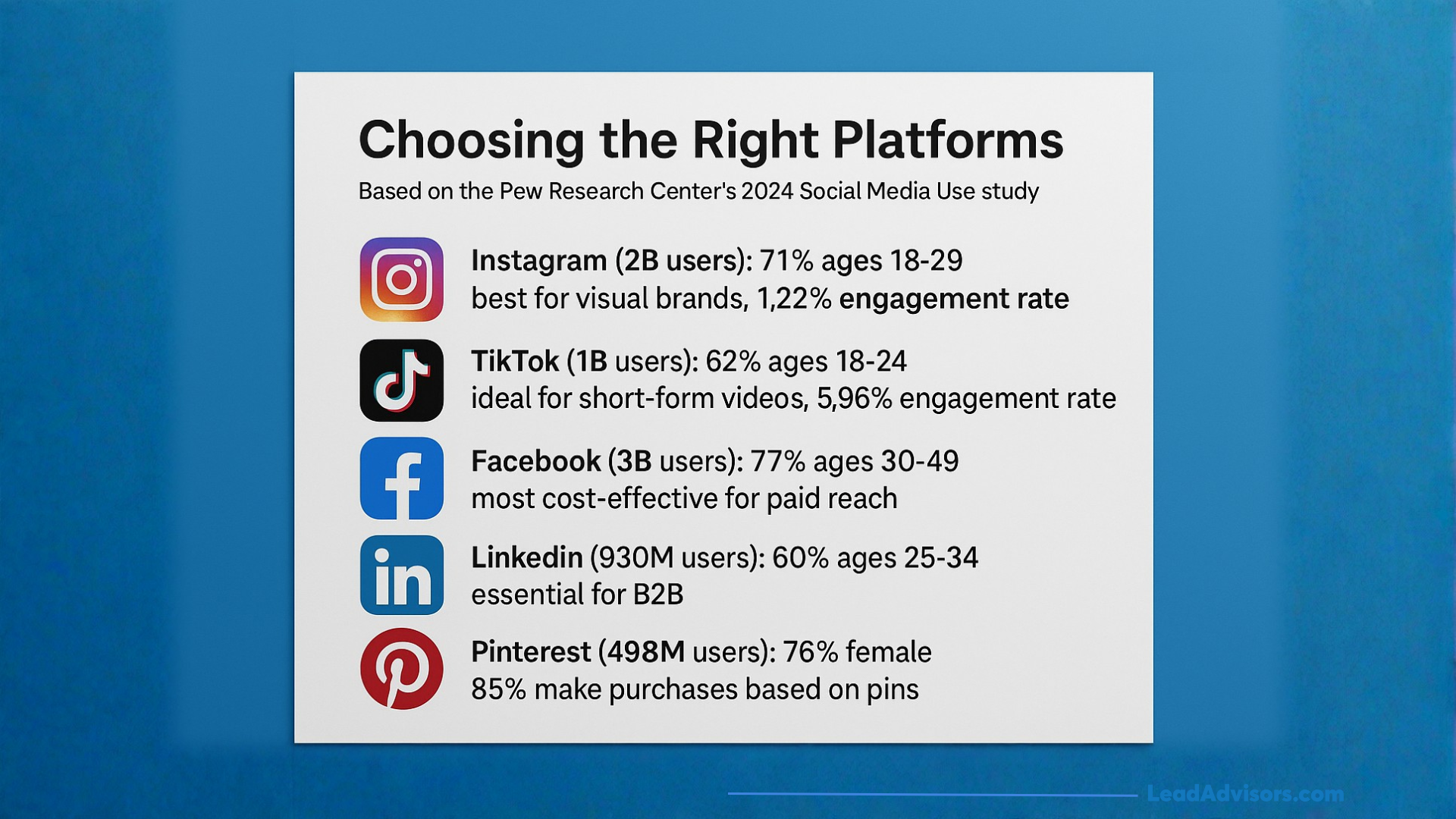
Select social media platforms where your target audience actively engages, based on the Pew Research Center’s 2024 Social Media Use study:
- Instagram (2B users): 71% ages 18-29, best for visual brands, lifestyle products, e-commerce. Average engagement rate: 1.22%.
- TikTok (1B users): 62% ages 18-24, ideal for short-form videos, entertainment, creative products. Average engagement rate: 5.96%—highest of all social media platforms.
- Facebook (3B users): 77% ages 30-49, effective for community building, local business, and older demographics. Remains the most cost-effective for paid reach despite declining youth usage.
- LinkedIn (930M users): 60% ages 25-34, essential for B2B, professional services, thought leadership. Decision-makers spend 17% of their online time here.
- Pinterest (498M users): 76% female, strong purchase intent with 85% making purchases based on pins. Ideal for e-commerce, recipes, home decor, and fashion.
- X (Twitter) (550M users): Best for real-time engagement, news, tech communities, customer service.
- Reddit (430M users): 100,000+ niche communities, 21.1 billion monthly screen views. Users spend 10+ minutes per session—far exceeding most social media sites.
- YouTube (2.7B users): Second-largest search engine after Google. Video content remains accessible for years, continuing to drive traffic.
Content That Drives Traffic
Social media posts must balance engagement with traffic generation. BuzzSumo’s analysis of 100 million Facebook posts found that content teasing valuable information generates 3.2x more clicks.
- Teasers to longer content: Share the first three tips from a 10-tip article, directing followers to your site for the complete guide. CoSchedule research shows this increases click-through rates by 47%.
- Short videos: Create 15-60 second videos demonstrating value with clear calls-to-action. Wyzowl’s research shows 84% of consumers were convinced to purchase after watching a brand’s video.
- Carousels: Multi-slide posts increase engagement and allow progressive storytelling that culminates in a site visit CTA. Instagram and LinkedIn carousels perform exceptionally well for educational content.
- Behind-the-scenes: Authentic glimpses into your business processes build connection and trust. Stackla research found that 86% of consumers value authenticity when deciding which brands to support.
- UGC (user-generated content): Repurpose customer testimonials, reviews, and photos. Nielsen research found that user-generated content is trusted 92% more than traditional brand content and generates 6.9x higher engagement.
Amplification Tactics
Maximize reach through strategic distribution techniques.
- Hashtags: Use 3-5 relevant hashtags per post on Instagram, 1-2 on Twitter. TrackMaven analysis found that Instagram posts with 11 hashtags receive the highest engagement, though best practices vary by platform.
- Cross-posting: Share content across multiple platforms, adapted for each channel’s format and audience expectations. Buffer data shows cross-posting can increase total reach by 300% when properly customized.
- Tagging collaborators: Tag people and brands mentioned in your content to encourage people to share. Mentionlytics research shows tagged posts receive 56% more engagement than untagged posts.
- Timing optimization: Post when your target audience is most active. Sprout Social research shows posting during peak hours increases engagement by 23-47%, though optimal times vary by platform, industry, and business category.
Influencer & Creator Partnerships
Influencer marketing leverages established audiences and trusted voices to expand reach.
- Micro-influencers: Creators with 10,000-100,000 followers often deliver better ROI than mega-influencers. Markerly’s analysis of 800,000 Instagram accounts found micro-influencers average 4% engagement versus 1.7% for accounts with 1M+ followers.
- Value exchange strategies: Offer free products, affiliate commissions, or collaborative opportunities rather than always paying fees. Influencer Marketing Hub research shows 37% of micro-influencers accept product-only compensation, making influencer marketing accessible for small businesses.
- Affiliate partnerships: Create commission structures incentivizing promotion. According to Forrester Research, affiliate marketing delivers 15-30% of total digital marketing sales for many brands, providing performance-based promotion strategies that align incentives.
List Your Website in High-Value Directories
Online directories remain crucial for local visibility and credibility, especially for small businesses with a physical location. BrightLocal’s 2024 survey found 98% of consumers use the internet to find local business information.
Business & Local Listings
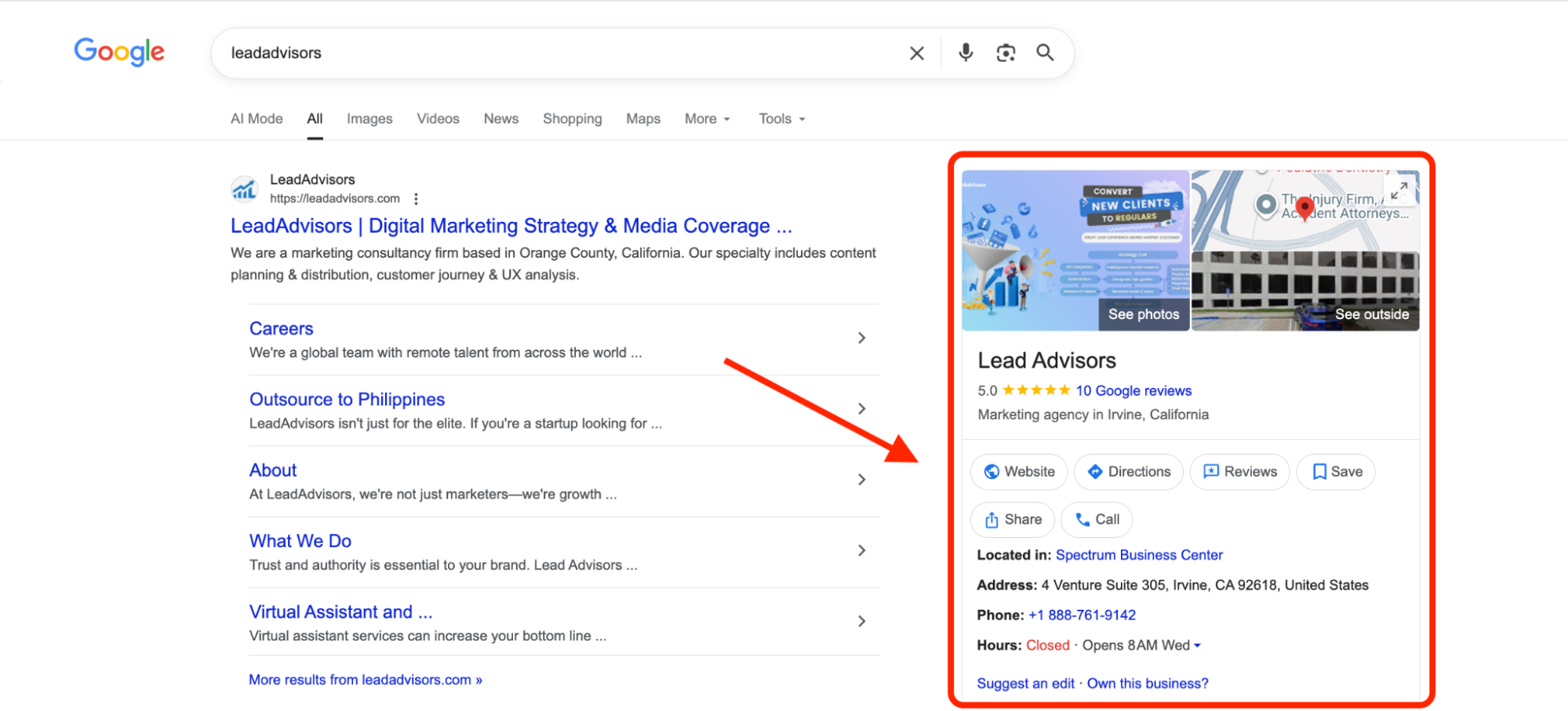
Google Business Profile: Most critical listing for local visibility. Google’s data shows that complete Google Business profiles receive 70% more location visits and 50% more website clicks than incomplete listings. This is your starter move for local presence.
Yelp: 148 million reviews, trusted by 57% of consumers. Harvard Business School research shows a one-star Yelp rating increase leads to 5-9% revenue growth for restaurants and local businesses.
Bing Places: Powers Apple Maps and Bing search results. Bing captures 7% of the U.S. search market share—substantial volume often overlooked by businesses focusing solely on Google.
Niche-specific directories: Industry-focused directories provide targeted exposure to qualified audiences. According to Moz, relevant niche directory listings contribute to local pack rankings and provide qualified referral traffic from people actively searching within your industry.
Optimization Tips
Consistent NAP: Name, Address, Phone number must match exactly across all listings. Moz’s Local Search Ranking Factors survey shows citation consistency accounts for 13% of local pack ranking factors. Even minor variations confuse search engines and dilute authority.
High-quality images: Upload professional photos of your location, products, team, and work examples. Google data shows listings with photos receive 42% more requests for directions and 35% more click-throughs to websites.
Reviews & responses: Encourage satisfied customers to leave reviews and respond to all feedback professionally. Northwestern University research shows that responding to reviews increases customer trust by 33% and signals to search engines that you actively manage your business profile.
Local landing pages: Create location-specific pages on your website targeting local keywords. BrightLocal research found that businesses with dedicated local landing page experiences see 47% higher conversion rates from local search traffic, as pages address specific geographic needs and build local relevance.
Tap Into Online Communities
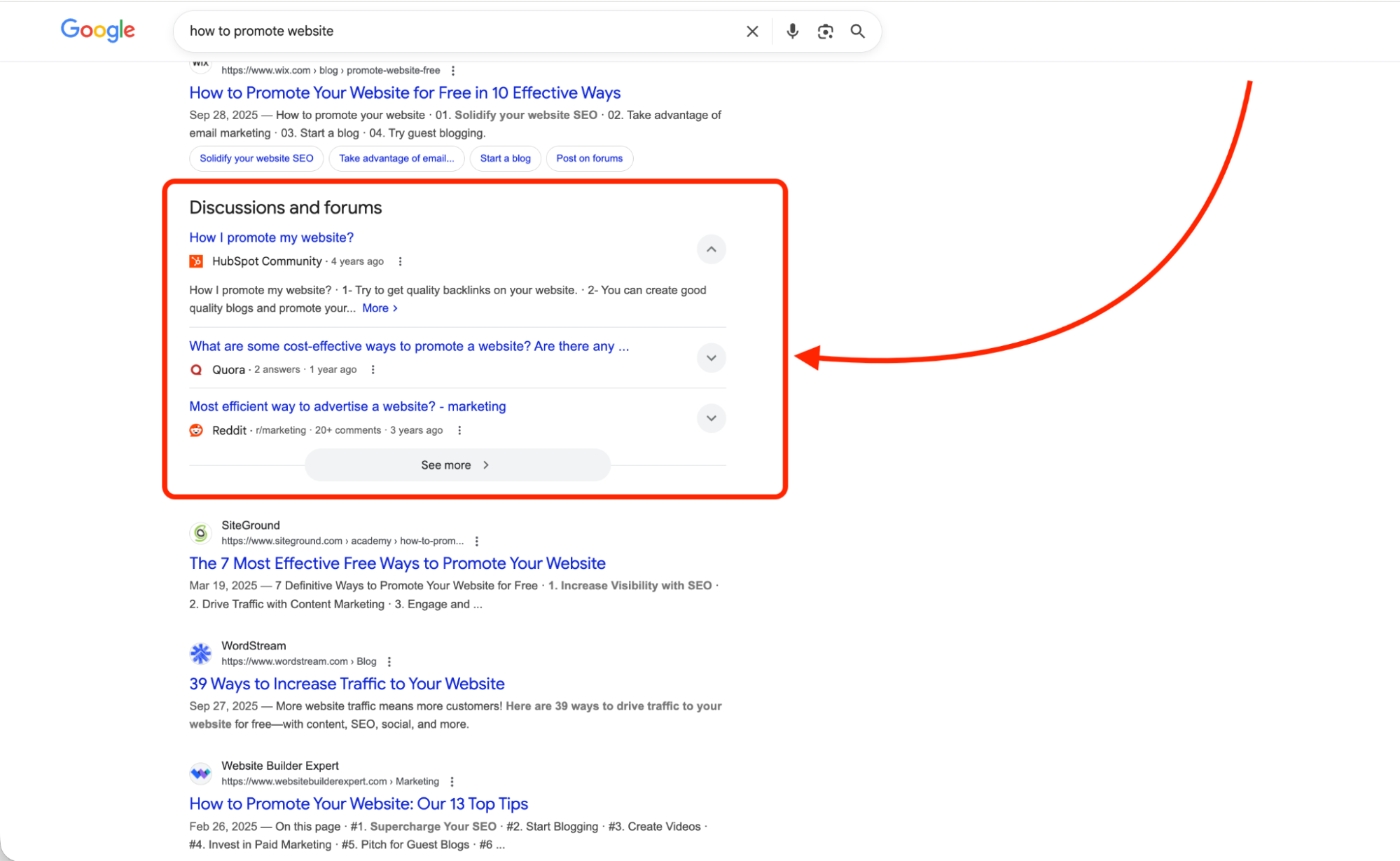
Strategic participation in online community spaces builds authority and drives qualified traffic. Sprout Social found 89% of consumers will buy from brands they follow, but 78% unfollow brands posting too much promotional content.
Where to Engage
Reddit communities: 430M monthly users organized into 100,000+ niche subreddits. Reddit drives 21.1 billion screen views monthly, with users seeking authentic advice and solutions from knowledgeable community members.
Quora answers: 300M monthly users. Thoughtful responses can drive traffic long-term—Quora data shows top answers receive 50,000+ views over their lifetime, providing evergreen referral opportunities.
Facebook & LinkedIn groups: Private groups foster deeper connections than public pages. GWI research found group members are 3.8x more likely to make purchases based on community recommendations, as trust builds through repeated interactions.
Niche forums: Industry-specific forums contain highly engaged decision-makers actively researching solutions. While smaller than major social platforms, niche forums often have concentrated audiences with high purchase intent.
How to Add Value (Without Being Spammy)
The cardinal rule: educate first, promote occasionally.
Educate first: Provide detailed, actionable advice without holding back to drive traffic. Carnegie Mellon studies on reciprocity show that genuine helpfulness increases eventual site visits by 210% compared to vague answers with links.
Link sparingly: Share links only when they provide substantial value beyond your comment. Backlinko research found community-driven backlinks pass 3.4x more link equity when they come from established, helpful contributors rather than obvious self-promoters.
Build authority through consistency: Regular quality contributions compound over time. Orbit Media research shows that community members who have consistently for 6+ months develop referral traffic that increase 35% monthly through word-of-mouth recommendations from other members.
Create Your Own Community
Building proprietary communities establishes you as the central authority while creating spaces for your target audience to connect.
Discord or Slack group: Host real-time conversations and provide immediate value. CMX’s State of Community Management 2024 report shows brands with active communities see 67% higher customer lifetime value and 44% lower churn rates.
Member forum: Create a dedicated forum space on your website that keeps discussions on your owned platform and improves SEO through user-generated content. Forums create massive amounts of indexed content around topics relevant to your business.
Email-based communities: Simple email lists or newsletters can foster strong community bonds without complex platforms. Litmus research shows community-focused emails generate 3.1x higher engagement than promotional messages.
Email Marketing: Turn Visitors Into Returning Traffic
Email marketing consistently delivers the highest ROI of any digital marketing channel. Litmus’s 2024 report shows email marketing generates $42 for every $1 spent—a 4,200% ROI that makes it essential for anyone learning how to promote their website effectively.
Grow Your Email List
Your email list is a marketing asset you own, unlike social followers subject to algorithm changes. DMA shows that for every 1,000 subscribers, the average business expects $7,800 in annual revenue.
- Lead magnets: Offer specific solutions to specific problems—templates, checklists, guides, tools. HubSpot’s analysis of 40,000 landing page experiences found targeted lead magnets convert at 9.7%, compared to 2.1% for generic newsletter signups.
- Pop-ups: Exit-intent pop-ups capture visitors before they leave, converting at 2-4% (OptinMonster data). Scroll-based popups appearing after 50-70% scroll depth indicate genuine interest and convert at 4-8%.
- Landing pages: Dedicated landing page experiences outperform generic forms. Unbounce’s conversion benchmark report shows focused pages with single clear offers convert at 9.7%, while pages with multiple CTAs average 2.9%.
- Social CTAs: Include email signup calls-to-action in social media bios, posts, and Stories to capture interested followers who want deeper engagement than social platforms provide.
Email Campaign Types
Balance value delivery with strategic traffic generation. Campaign Monitor’s analysis of 30 million emails found effective campaigns follow a 90/10 rule: 90% valuable content, 10% promotional asks.
- Newsletters: Regular updates keep subscribers informed and engaged. MailChimp data shows that consistent newsletters maintain 20% higher open rates than sporadic sending, as subscribers come to expect and anticipate your messages.
- Updates: Announce new content, products, features, or company news to drive traffic to specific relevant pages. Keep subscribers informed about what’s new while directing attention strategically.
- Blog highlights: Share the latest blog posts with compelling content summaries that encourage people to click through. MailChimp research shows digest-style emails generate 3.7x more clicks than promotional emails.
- Product announcements: Introduce new offerings to your warmest audience first, leveraging the trust you’ve built. Subscribers are more receptive to new products than cold audiences since they’ve already demonstrated interest.
Best Practices
Compelling subject lines: Test different approaches to improve open rates. Optimizely research shows that companies conducting regular A/B tests on emails see 37% higher engagement rates and 49% more conversions.
UTM parameters: Tag all email links with UTM parameters to track performance in Google Analytics. Cardinal Path research found marketers using consistent UTM tagging make 43% more data-informed decisions than those relying on basic analytics.
Personalization: Go beyond first names—segment by behavior, interests, and previous interactions. MailChimp analysis of 11 billion emails found personalized campaigns generate 26% higher open rates and demonstrate understanding of subscriber needs.
Segmentation: Send targeted content based on subscriber data. MailChimp found segmented campaigns generate 100.95% higher click-through rates than non-segmented campaigns, as relevance drives engagement.
Paid Promotion Options
While organic strategies build long-term traffic, paid promotion accelerates results when implemented strategically. WordStream’s 2024 benchmarks show the average business generates $2 in revenue for every $1 spent on Google Ads—though results vary significantly by industry and implementation quality.
Search Advertising
PPC basics: Pay-per-click advertising on search engines like Google and Bing captures high-intent users actively searching for solutions. You only pay when someone clicks, making it a performance-based investment.
Keyword bidding strategy: Bid on keywords matching strong purchase intent rather than broad informational terms. WordStream research shows Google Ads on commercial intent keywords convert 50% better than informational queries.
When it makes sense: Use Google Ads (formerly Google Adwords) when you have proven offers, clear customer lifetime value, and the ability to track ROI. Harvard Business Review research analyzing 500 companies found businesses combining paid and organic strategies achieve 25% higher growth rates than those relying solely on organic tactics.
Social Media Ads
Paid social media marketing builds awareness and drives traffic across major platforms.
| Platform | Avg CPC | Conversion Rate | Best For |
| Meta | $1.72 | 2.11% | Visual products, broad demos |
| TikTok | $1.00 | 1.90% | Brand awareness, younger users |
| $5.26 | 2.74% | B2B, professional services | |
| $1.50 | 2.30% | E-commerce, visual discovery |
Retargeting
Most visitors don’t convert on first exposure—bring them back strategically.
- Visitors: Show ads to anyone who’s visited your website. Criteo research shows website visitors who see retargeting ads are 70% more likely to convert than those who don’t see retargeting.
- Abandoned carts: Remind shoppers of products left behind. Barilliance research found cart abandonment retargeting recovers 10-15% of otherwise lost sales, making it one of the highest-ROI ad tactics.
- Email subscribers: Retarget subscribers with relevant offers based on their engagement history. Since they’ve already opted into communication, retargeting ads reinforce your message across multiple touchpoints.
Sponsored Content
- Sponsored reviews: Pay for product reviews on relevant blogs or YouTube channels. Unlike pure advertising, sponsored reviews provide a detailed evaluation that addresses buyer objections.
- Dedicated placements: Secure featured positions in newsletters, podcasts, or media properties reaching your target audience. These placements combine paid reach with editorial context.
- Paid partnerships: Collaborate with complementary brands or influencers on co-marketed campaigns. Shared costs and combined audiences make partnerships more cost-effective than solo campaigns.
Low-Cost & No-Cost Website Promotion Tactics
Not every small business has a substantial marketing budget. The U.S. Small Business Administration shows small businesses allocate 7-8% of revenue to marketing, with newer businesses often investing 12-20% to establish market presence.
- Blog commenting (value-added): Leave thoughtful comments on industry blogs with genuine insights. Include your website link in the profile field, but focus on adding value rather than promoting. Well-known blogger Derek Halpern built early traffic through strategic blog commenting.
- Answering questions in communities: Provide detailed answers on Quora, Reddit, and niche forums without immediate self-promotion. Your expertise becomes evident through helpful responses, and interested readers click through to learn more.
- Giveaways and contests: Run giveaways requiring participants to visit your site and take specific actions. According to Tailwind research, contests generate engagement rates 3.5x higher than standard posts and rapidly build email list size.
- Offering free tools or resources: Create calculators, templates, or tools providing immediate value. Ahrefs’ analysis shows free tools earn 3.4x more backlinks per page than traditional content while establishing authority.
- Word-of-mouth referral loops: Make sharing easy and rewarding. Wharton School research shows referred customers have 16% higher lifetime value and 37% higher retention rates than non-referred customers.
- QR codes on physical materials: Place QR codes linking to specific offers or resources on receipts, product packaging, in-store signage, and employee name tags. Statista shows 89 million U.S. smartphone users scan QR codes regularly, bridging offline and online experiences.
- Low-cost influencer swaps: Exchange products or services with micro-influencers rather than paying cash. Many creators accept product-only compensation, especially when they genuinely like what you offer.
- Free educational webinars: Host free webinars, establish expertise, and collect email list signups. ON24’s Webinar Benchmarks Report shows webinars convert attendees to customers at rates 2-5x higher than other content formats.
Track, Measure, and Improve Your Results
Promotion without measurement wastes resources. Gartner’s 2024 survey shows 72% of marketing budgets are now allocated based on performance data, up from 46% in 2020—a clear shift toward accountability.
Channel-Level Performance
Use Google Analytics to understand where visitors originate. Ruler Analytics research examining 50,000 conversions found that businesses that accurately attribute traffic sources make 44% better budget allocation decisions.
Track these metrics by channel:
- Organic search: Long-term growth from SEO efforts
- Direct traffic: Brand awareness and repeat visitors
- Referral traffic: Backlinks and partnerships
- Social traffic: Social media effectiveness
- Email traffic: Campaign performance
- Paid traffic: Ad campaign ROI
Referral vs Organic vs Direct Traffic
Referral traffic comes from other websites linking to you. High engagement rates signal quality backlinks. Low engagement suggests low-quality sources worth ignoring.
Organic search traffic indicates SEO success. Monitor which keywords drive the most qualified visitors and which pages attract the most organic search traffic.
Direct traffic shows brand recognition and repeat visitors. Growing direct traffic suggests that brand awareness efforts are working, as people remember and return to your site.
Conversion Tracking
Monitor conversion rates by traffic source. Google Analytics lets you set up goal tracking for specific actions—form submissions, purchases, downloads, or any meaningful engagement. According to Kissmetrics, businesses tracking conversions across multiple touchpoints see 35% higher conversion rates.
Time-on-Page Insights
Engagement metrics reveal content quality and relevance. Pages with high time-on-page and low bounce rates indicate engaging content that satisfies search intent. Pages with quick exits need improvement—either the content doesn’t match expectations or isn’t compelling.
Repeating What Works
Double down on channels and tactics delivering results. If specific blog posts consistently attract traffic and convert visitors, create content on similar topics. If certain social media platforms outperform others, shift focus there. This seems obvious, yet many businesses spread effort evenly rather than optimizing based on performance.
Cutting What Doesn’t
Eliminate or minimize tactics that drain resources without delivering measurable results. VWO research shows that companies willing to kill underperforming initiatives achieve 2.3x better overall results by reallocating resources to what works.
Common Mistakes to Avoid
Even experienced marketers fall into these traps when learning how to promote your website.
- Only promoting once: Publication isn’t promotion. Share new content multiple times across different channels over weeks or months. Social media algorithms ensure most followers miss any single post, so repetition reaches more people.
- Publishing low-quality content: Google’s helpful content update prioritizes genuinely useful content over content created primarily for search rankings. One excellent, comprehensive piece outperforms ten shallow articles every time.
- Ignoring technical SEO: Search engines won’t rank sites they can’t properly crawl and understand, no matter how great your content. Technical foundations determine whether your content marketing efforts can succeed.
- Not building links: Many businesses focus exclusively on on-page SEO and ignore link building. Since backlinks remain a top ranking factor, neglecting off-page SEO severely limits potential rankings and website traffic growth.
- Being promotional in communities: People spot self-promotion instantly in communities. Provide genuine value in social media groups and forums, or you’ll be ignored, downvoted, or banned. The 10:1 ratio—help 10 times before asking once—prevents this mistake.
- Inconsistent posting: Sporadic posting of content confuses algorithms and audiences. Consistency builds momentum and trust, while irregular publishing suggests unreliability and reduces visibility.
- Relying solely on ads: Paid advertising delivers immediate results but creates dependency. The moment you stop paying, traffic disappears. Organic strategies build sustainable growth that compounds over time.
- Neglecting analytics: You can’t improve what you don’t measure. Installing analytics tools is pointless if you never review data and adjust based on insights. Data-driven decisions outperform intuition consistently.
Frequently Asked Questions
How do I promote my website on Google?
How can I promote my website for free?
How do I promote my website on social media?
How do I promote my website on Google Search?
What is the most effective way to promote a website?
Final Thoughts
Website promotion is a long-term strategy requiring patience and consistency. Sustainable growth beats quick hacks every time. The most effective approach combines SEO + content + authority signals for compounding results.
Understanding how to promote your website in 2025 means mastering multiple promotional strategies—from search engine optimization and content marketing to social media marketing and email marketing. Whether working with an SEO company or doing everything yourself, the principles remain: create content that serves your target audience, optimize for search engines, build brand awareness through multiple channels, and continuously measure and improve.
The websites that win combine digital marketing excellence with authentic relationship building. They understand that getting more website traffic isn’t about gaming systems—it’s about providing so much value that other sites, search engines, and real people naturally want to send visitors your way. Focus on promotional strategies that compound over time, and you’ll drive traffic to your website that converts into lasting business success.



